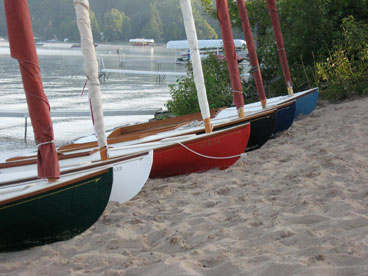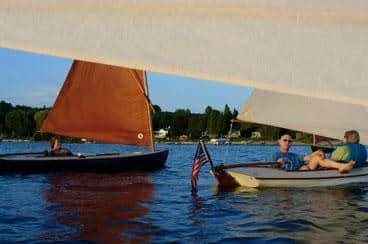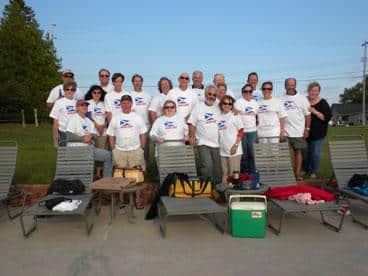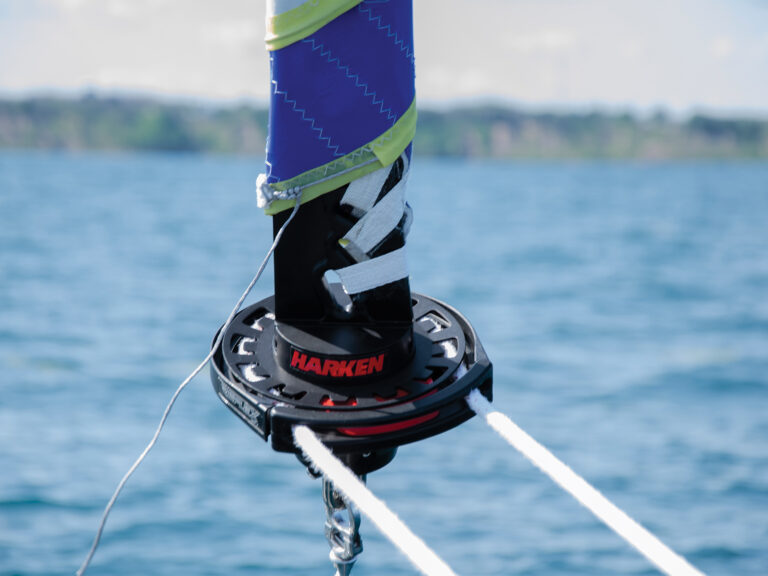
Melonseed Skiffs
Three years ago, on an eastbound flight out of Milwaukee, lifelong sailor Don Traut wistfully peered upon the sunlit waters of Lake Michigan. He was suddenly captivated as the plane’s shadow crossed the lake’s eastern shore.
A turquoise-rimmed pond had appeared, long, broad, and circumscribed by white sand. Prevailing westerlies, slipping over a narrow bank of shoreline, would scarcely be impeded, making the smaller body of water breezy while still protected. Home in Cincinnati, Don called a friend in Indiana, Roger Rodibaugh, who promptly did legwork on the ground, and the Melonseed Skiff Midwest Rendezvous had discovered a new destination.
Fifteen Melonseed Skiffs, a dozen from the Midwest, two from Montréal, and another from Annapolis, Maryland, were towed to Crystal Lake, Michigan, in late July 2009 to sail on waters deserving the name. In 1873, the water level was artificially lowered when the Army Corps of Engineers dug a channel to connect to Lake Michigan. That trench would be plugged, the project a failure, but the swift outrush of water exposed a sandy beach. Shoreline waters sparkle with such clarity that a skipper can be surprised by a sail’s shadow appearing for an instant on the bottom 20 feet below, and looking like surface rock.
Don and Sheila Traut are original members of the Midwest fleet, helping to launch the rendezvous in the 1990s with just three boats. A competitive Laser sailor during his university days, Don now owns a 19-foot Menger Catboat, but he regularly travels with his 14-foot Melonseed and a pair of kayaks. His well-used ivory Catspaw is hull number 33 of the approximately 440 built to date, and was the senior vessel at the rendezvous.
On a still morning, Don and Sheila take to their kayaks at dawn. When the wind fills in, Don assumes his customary pose at Catspaw’s helm. Often he’s down on the lee side, his back comfortably against the cockpit coaming and his feet up to windward, hanging over the rail. The picture seems the epitome of a sailor at ease in his element.
Melonseed sailors are affectionately known as Melonheads. The majority have owned or still own larger boats. Doc Muse-kamp, of Madison, Wisconsin, and his wife Teri, also sail a unique 26-foot Phil Bolger sharpie schooner with leeboards. Doc—a nickname, not a profession—took advantage of a 10-knot breeze to beat to weather to the lake’s opposite shore. Now that the rendezvous has gone to Crystal Lake in successive seasons, after many years at Green Lake, Wisconsin, beating the eight miles to weather to the far end has become a rite of passage. Rewards for the bash include beautiful swimming waters, a well-deserved lunch, and a fast, jubilant run back. The wind fell for the last quarter of a mile as Doc returned in his dark-blue-hulled Indigo, so Teri helped out by pulling on an oar—all worth the effort, as both counted it a great sail. Doc even made his directorial debut, posting a video of the rendezvous on YouTube:
What unites Melonheads is their affection for the boat. With its quaint but fetching sprit rig, the design dates back to the New Jersey shore of the 1880s, and while various iterations appear in wood, the Roger Crawford boat, now in its 21st year of continuous production, is exquisitely and solidly constructed in fiberglass. The legend, often told, bears repeating. Roger operated a shop in Humarock, Massachusetts, building dories and repairing whatever came his way. What came his way one day was a call from a man with a 100-year-old vessel in woeful shape. Knowing how labor intensive and money losing such romantic projects can be, Roger told the man bluntly that he wouldn’t be in his shop when he arrived. The man came anyway. Roger took pains not to run into him as the relic was towed up and down Humarock streets. Eventually, perhaps conceding defeat, yet perhaps also with great wisdom, the gentleman simply abandoned the boat on Roger’s doorstep. Knowing a disaster when he saw one, Roger stuck the boat behind a shed and covered it in wraps, to be dealt with another day.

Like any good small-boat shop, Roger Crawford’s is also a spot where people drop by for a chat and the chance to inhale the scents of freshly hewn woods and savor boats in the making. These visitors kept slipping out back to admire the lines of the relic. They were smitten. Before long, Roger took the wraps off to give her a look himself. She was certainly a disaster. She was also certainly a beguiling beauty. He repaired her with the intention of building a mold. Test-sailing the repaired hull, he was mesmerized. The boat could sail! Since she could handle the rough stuff, he chose to increase the sail area and cockpit capacity and build her to the most rugged of big-boat standards while also making her an aesthetic masterpiece.
Crawford’s shop now handcrafts 20 Melonseeds every year, with lavish care paid to each one. Mast, sprits, tiller, rudder, floorboards, and trim are executed in wood. Originally designed as a gunning skiff, the Melonseed has maintained its loyal following over time due to its near-legendary capability to handle seas and winds. Nobody wants to be out in 40 knots, but at Crystal Lake, when the wind on Saturday morning hit 15 knots ahead of a cold front, then built quickly to 20 with gusts out of the southwest at 30, Melonheads were out in their glory, hooting with delight. And you don’t reef a ’seed!

Melonheads enjoy an annual regatta out of Humarock each year, but it took a while to get a widely dispersed Midwest group going. Roger Rodibaugh is the principal energizer. From Indiana, he brought along Sue Christopher on Gem this year; she’s new to sailing but put in six-hour days tacking back and forth off the beach. Roger also arrived with Don Baldwin on Sally Lyn, hull number 422. Don literally owns a barnful of boats variously driven by engine, wind, or oar, but he’s taken to the Melonseed like no other. On his inaugural sail, Don was unexpectedly caught out in 30 knots, yet he reveled in the sail as his vessel proved its mettle.
From her home in Missouri, Karen Pautz has put as many as 10,000 miles a year on her boat trailer. Her wit and wisdom is much appreciated by all—in the recent Cash for Clunkers flurry, she replaced her Ford named Harrison with one she calls Betty. Annually, she attends the Midwest gathering, while early winter finds her sailing her dark-blue Folderol out of Punta Gorda, Florida. Boats have always been part of her life, as have horses. As a child, she’d sit astride the bow of her father’s sloop in chop and make believe that she was a riding a horse. These days, she’s responsible for the care of over 200 school horses; she sails to escape the stress. If not on her Melonseed, she can also be found on her 23-foot Stone Horse, Dressage Queen, on Missouri’s Lake Stockton. And now, when riding a horse, she just may be dreaming of her next sail on Folderol.
Trevor Ferguson (a.k.a. John Farrow) just published his ninth novel, River City. He used to race a Niagara 26, but now he enjoys sailing Otter, his Melonseed Skiff, on the waters of Quebec and New England.







